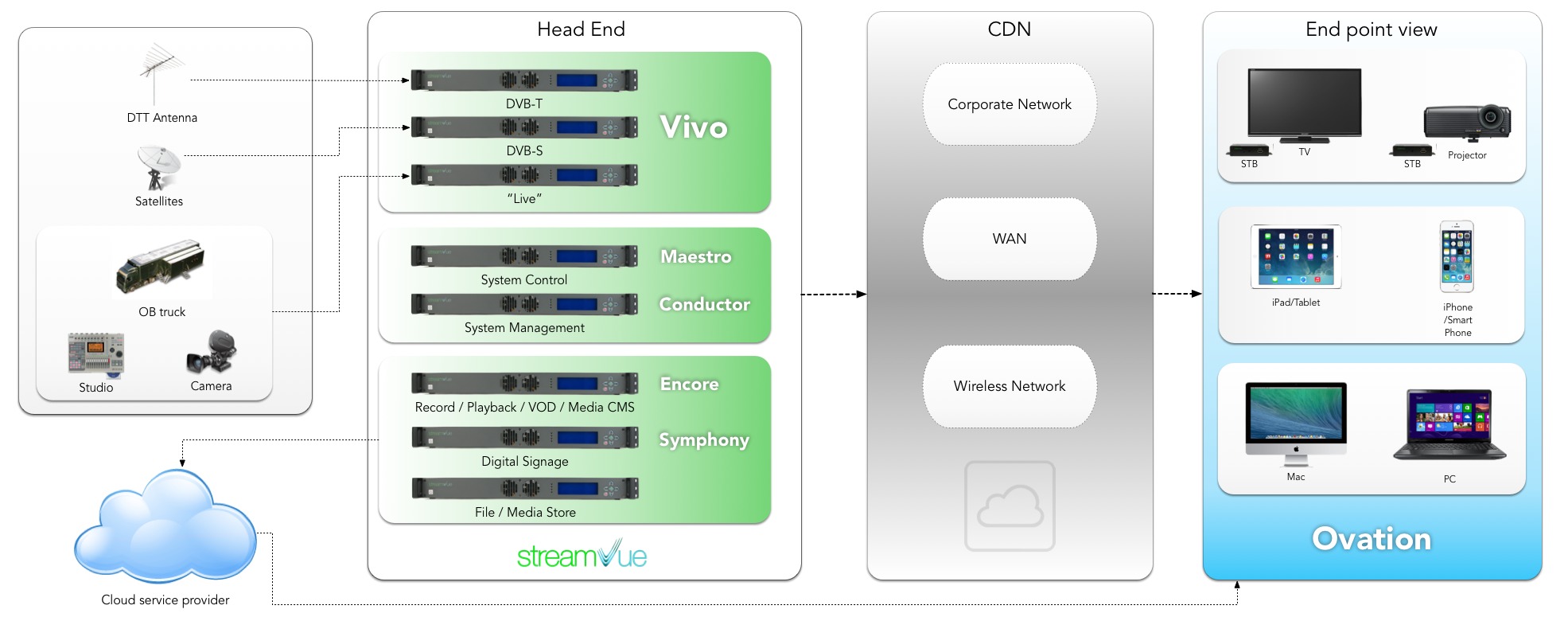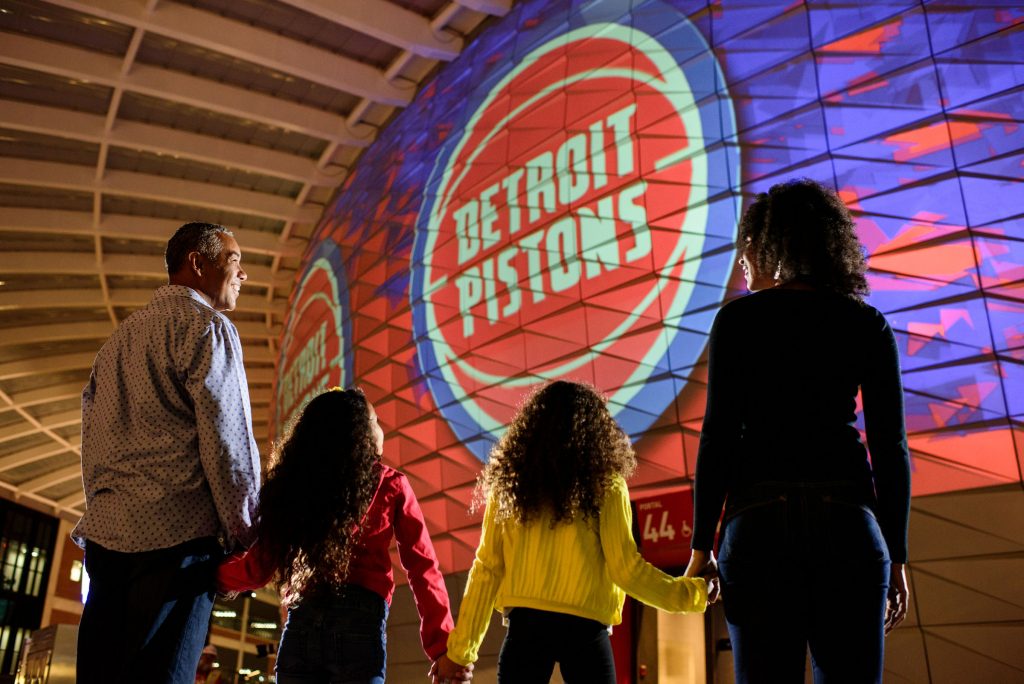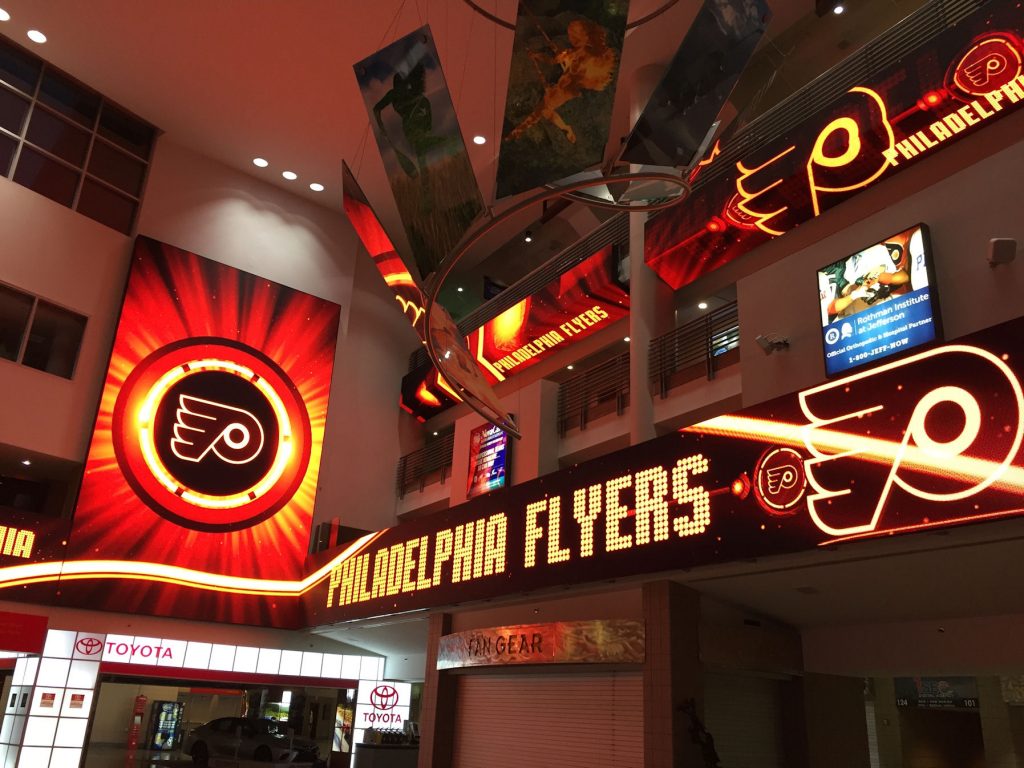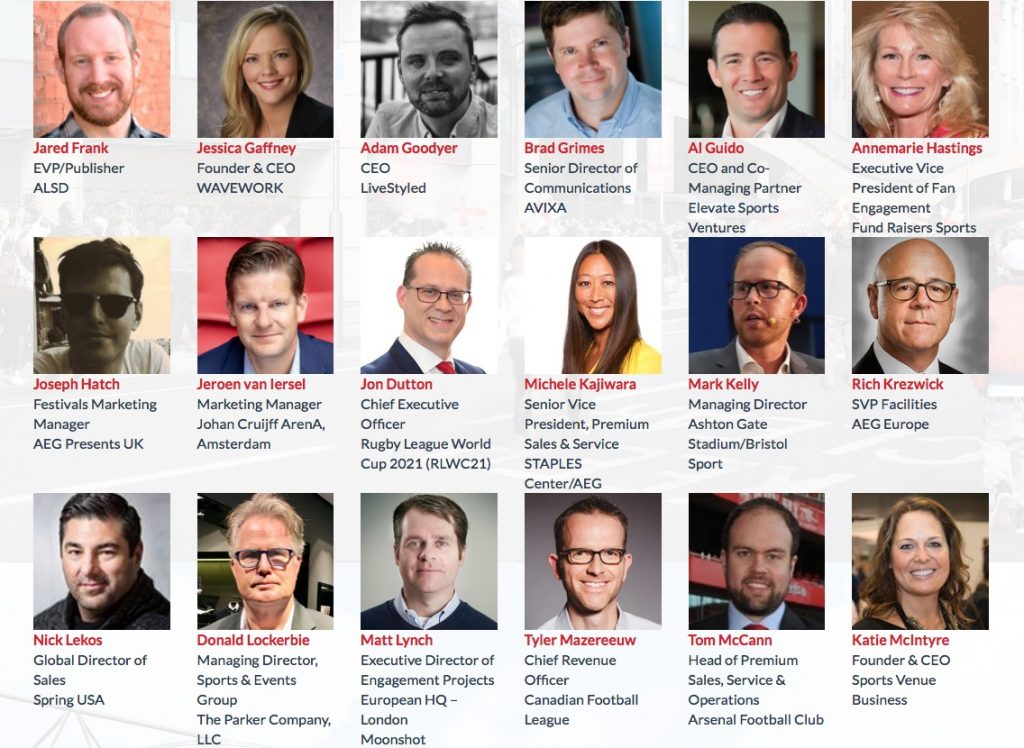- October 4, 2018
- Posted by: SportsV
- Categories: Case Studies, Event News, Featured Articles, Features, Home News, Industry News, News, Press Releases

This article, authored by IT expert, Matt Richards, takes a generic look at the technology, then relates this to the ways it can be used to benefit stadiums and venues.
While each venue is unique, the following information will provide guidance on the business case and how a real return on investment can be established. Finally, I will share tips and advice on the functional needs of a system in order to avoid the common pitfalls and turn the theoretical benefits into reality.
IPTV as a technology has been around and used in stadia for some time, in fact the first example where it was used extensively that I am aware of is in 2006. Since then many venues have implemented this to some extent, if so, keep reading as its capabilities have developed considerably and it may be time to check that you are maximising the benefits of your investment.
What is IPTV
Internet Protocol Television (IPTV) is the delivery of media content, such as live television, camera feeds and videos over an IP network. The IP network can be within an organisations single location known as the Local Area Network (LAN), which utilises the existing investment on structured cabling and network switches, and / or over an organisations wide area network, between sites and even over the public internet.
What is Digital Signage
The term digital signage is an outdated industry ‘catch all’ phrase, which traditionally refers to static text and images designed by a customer and displayed on a TV screens. For example, welcome messages and static advertising.
Wikipedia definition is: Digital signage is a sub-segment of electronic signage. Digital displays use technologies such as LCD, LED, projection and e-paper to display digital images, video, web pages, weather data, restaurant menus, or text.. They are used as a network of electronic displays that are centrally managed and individually addressable for the display of text, animated or video messages for advertising, information, entertainment and merchandising to targeted audiences.
Digital signage platforms now tend to be a hybrid digital video mixer and signage appliance used to create and manage IPTV content channel streams that can consist of any mix of live video, stored video, real time data and textual or graphical content.
From a systems architecture perspective, or what the building blocks for a system are, they involve three elements. The first two of these elements reside in what is known as the head end, which is where all the feeds and connections to the network occur, which is normally some space in the central IT computer room.
The first element is where feeds are converted into IP packets via a process called encoding on dedicated hardware. The second element of the system located in the head end is content and management appliances, also typically on its own hardware. The third element to the system is at each end point, normally for screens a set top box that physically sits behind each screen and takes the network connection and converts it into a signal that is then connected to the screen, similar to a Sky box, but much smaller and out of sight.
It is worth noting that screens are not just traditional TV screens but can also be large LED displays and pitch side digital hoardings or video walls.

Benefits
By implementing IPTV and Digital Signage the venue has essentially turned every screen into a digital asset to drive revenue, communicate and entertain. As stated in the introduction, every venue is unique and therefore so are the benefits, so the following captures some of the main common benefits, rather than an exhaustive list. To simplify these, I have put them into three broad categories. The first being operational, secondly revenue and thirdly but by no means least, the fan experience. Each benefit could have a monetary value put next to it.
Operational Benefits
Venues are by their nature large and difficult to move around quickly when an event is on, then central management and control is essential. An IPTV system provides this central management and control, an absolute must is to ensure every screen itself is able to be completely managed via the IPTV system. This will allow screens to be scheduled when they are turned on and off, the volume, aspect ratio and control of the exact channel and what content is shown. Imagine the cost of electricity and time saved of turning on and off each screen, as well as constantly checking and trouble shooting unhappy customers. Screens that are not turned off, will not only cost the venue in electricity, but will also need to be replaced more frequently.
Picture quality improves, because IPTV encodes TV channels into IP packets that are digital and do not deteriorates across the network, means high quality images to every screen. The alternative is to use a legacy coax cabling network with signal boosters that is unmanaged and picture quality deteriorates with the number of devices and cable length. The IPTV system is ultimately scalable, simply mount the screen and set top box, then connect to the data network.
Assistance in emergency evacuation, given recent terrorist attacks on stadia and venues, then any help to direct people quickly and efficiently to a safe area in an emergency should be considered. Traditional screen systems can actually hinder this as fans can be distracted by screens continually showing content and the volume making emergency announcements unclear. With a well thought out IPTV system every screen can either be turned off immediately or used to direct people to the safest exit.
Cost of change, most venues host a variety of events and their purpose can change daily. By using screens rather than printed material then these changes happen instantly, in fact be scheduled well in advance. For example, concessions sold on a match day will be different during corporate hospitality, similarly concourse screens can be used for way finding and company promotional material.
Driving Revenue
The most obvious revenue creator is from advertising, obviously brands can have a great deal more exposure, that is quantified and able to be measured. Systems can easy report on the exact time an advert was shown and that the screens were physically on. Remembering that with the digital signage capability then the venue can decide exactly how something is shown and on what screens. This may be traditional full screen, or along the side, an overlay or banner.
Increase food and drink revenue, by both promoting what’s available, have on the day super deals which can clear excess stock and prevent wastage. Screens can also direct customers to units that are less busy.
Promote merchandise that is relevant to the day, for example every corporate area could have a dedicated channel to the products available, so they can be ordered and brought to them. This channel can be advertised throughout the day via a periodic ticker tape across the bottom of a screen. The choice of products to promote can be on the day, for example on a cold and wet day promote scarfs, hats and hand warmers, rather than T-shirts.
Increase ticket sales by using the system to inform customers of upcoming events and ticket availability, maybe for the next game or gala dinners, concerts along with exactly how to get their tickets.
Promote upgrades to corporate hospitality.
Promote betting partners, not just with a standard advert, but by offering bespoke club betting options, or running video of how make a bet and bet types available. I have seen this work to staggering effects at a racecourse, where the cost of the IPTV installation suddenly paled into insignificance. This approach, not just with betting can increase the value of sponsorship packages across the venue.
Run content promoting the venue’s other uses, such as conference and banqueting, Christmas parties and end of season pitch hire.
The IPTV system will help attract organisations to choose your venue, rather than others where they would need to hire in screens and resource to produce the experience they are looking for.

Fan Experience
Now you have full control over the content to each screen, then fan experiences can vary which will benefit the venue. For example at a football game, completely different content can be shown for home and away fans to set the scene for the match. This can be pre-match build up with messages from the manager and show highlights of the season so far for each team. Messages from the players and manager can build each teams excitement and engagement as well as respect for the opposition and hosts. Often this production can be created by the visiting team and a simple HLS link from the away club into the host venue is all that is needed. If fans know they will be entertained with content they are interested in the they will arrive earlier. As well as improving fan experience the engaging content this will encourage linger time and more loyal attendance, which translates into revenue.
Film guest speakers and broadcast it to other areas around the stadium, this can also be made available to other fans, such as a channel in VIP boxes. This also provides a back catalogue of material for ongoing use and promotion.
Provide access to promotional material of box holders and sponsors so they are able to show their guests their achievements by simply changing TV channel to a video that’s available on demand (VoD). This adds value to sponsors and can help retain or increase revenue.
Fan experience can go down to an individual level, for example when a loyal fan submits their ticket into a turnstile, screens can invite them into a VIP bar for a celebration drink on their birthday.
Theory to Reality
We have looked at what the technology actually is, along with the benefits which can help build the business case. Now it’s time to share ideas on how the turn this into reality, which is usually most challenging part.
It is easy to get lost in ‘techno babble’ and be very impressed providers market presence and the prestige names that they associate with. This will lead to your requirement veering towards what they are offering, rather than what you are trying to achieve.
A more successful approach would be to define what you would like each screen to show and when, remembering the screen can show multiple information from different sources at any one time. Think about the sources to information and how you would like them to be shown, for example from turnstile data, internet feeds, camera’s etc., don’t look to replicate data from other live systems, look for the IPTV system to integrate into it. Well thought out content should be relevant and fun, this can help create the whole atmosphere within the venue. The barriers should be people’s imagination, rather than the infrastructure that delivers it.
Alongside this, then work through system functionality that is important to you, here are some examples which are particularly relevant to stadiums and venues with live events:
- Ease of use is essential so all staff with the correct permissions can easily change and / or create content on their screens. For example, catering team can change menu boards and what promotions are running, marketing and events teams can control sponsorship material. This shares the responsibility for gaining the benefits of the investment across the business, rather than IT.
- Full screen control, so every device can be turned on / off set the channels, volume etc. centrally.
- Scheduling of everything, so precious event day resource is not dedicated to the IPTV system. Remember while everything should be scheduled, manual intervention is also key.
- Latency is very low, this historically has been a draw back on IPTV, but now should always be under 500ms.
- The ability to directly attached large format screens to reduce this latency to next to nothing.
- Sub secondly channel changing from remotes, there is nothing more annoying for users to wait prolonged periods simply for a screen to change channel, as per legacy hotel systems.
- Ability to control and manage video walls from the same interface.
- Sound synchronisation so the TV sound complements the stadium sound system rather than works against it, a common pit-fall and the results can create a horrible user experience.
Once these functional requirements are gathered, then this gives the basis of choosing the right provider. A pilot, where the provider proves their solution meets your requirements is recommended, and if it is not right or especially easy to use, then stop, because the benefits and ROI will not be achieved.

Author credits: Matt Richards is Business Development Director at StreamVue. He has over twenty years’ experience in the IT industry working with customers to provide a variety of innovative connectivity and communication solutions. Working with customers from defining the end result, creating the concept design, analysing technology available, building the business case and funding models, to being responsible for on site delivery and ensuring the desired end results are achieved. Historical roles have including working at a global manufacturer of RF products, which provide mobile and private mobile radio coverage. This involved working with mobile network operators across EMEA and large venues, such as Wembley and Heathrow to provide 2G/3G and 4G multi operator coverage. Matt is currently working for StreamVue who manufacturer real time IPTV distribution and digital signage products, which enable customers to improve communications, increase revenue and enhance the fan’s experience.
Optimising the fan/guest experience on the Premium Level, analysing the latest trends in technology and design, and delivering a return on investment are just some of the topics for discussion at next week’s ALSD International conference and exhibition. Some 60+ high-level industry experts will be sharing their insights with the 220+ registered attendees from clubs & teams, stadia, arenas & sports venues, architecture & design firms, leagues & federations, producers & suppliers during the 2-day event, being held at the Amba Marble Arch Hotel in Central London, October 10-12.

#ALSDInternational – Europe’s first Premium Seat event


